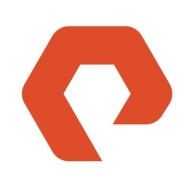


NetApp AFF and Pure Storage FlashArray are leading enterprise storage solutions. Pure Storage FlashArray has the upper hand with its advanced features and perceived value, despite higher costs.
Features: NetApp AFF is praised for its data management tools, broad protocol support, and robust support. Pure Storage FlashArray stands out with its performance optimization, real-time analytics, and extensive integration capabilities.
Room for Improvement: NetApp AFF users suggest enhancements in its data reduction, automation capabilities, and support during deployment. Pure Storage FlashArray users seek improvements in its high availability, cost management features, and ongoing support.
Ease of Deployment and Customer Service: NetApp AFF deployment is commended for flexibility, but users need better support during the process. Pure Storage FlashArray earns high marks for streamlined deployment and proactive customer support.
Pricing and ROI: NetApp AFF is recognized for its cost-effective setup and favorable ROI within a shorter timeframe. Pure Storage FlashArray, while more expensive initially, promises a higher long-term ROI due to its superior performance and efficiency gains.
By opting for the gold subscription every three years, you get a free upgrade to the latest controller release.
If you wait more than seven years to buy another one, you get a return on your investment.
In the long term, spanning three to five years, the total cost of ownership becomes cheaper, considering power consumption, data center footprint, and NVMe technology usage.
Our current workload, particularly the SQL use case, would not be possible on mechanical storage, and the ease of use for the small team for the array is important for supporting that workload.
We have seen a return on investment as the solution has reduced resource requirements, allowing less experienced personnel to manage the storage.
We also had one outage where a controller of one of the products had failed and had to be replaced on-site.
Customers always have their issues resolved promptly.
Pure has good storage.
The support for NetApp AFF is comprehensive—not just the documentation for self-guided reading, but for simple questions, spare parts, or urgent needs, you can have a contract that enables delivery the next business day or within four hours, depending on your process requirements.
I have communicated with them, and they are effective and responsive.
Pure's support organization is responsive with minimal bureaucracy, making support a key factor in customer retention.
I would rate the technical support an 11 out of 10.
The support from Pure Storage is excellent.
It is highly scalable.
It is suitable for both medium-sized and enterprise businesses.
It hasn't broken down anytime in the last six to seven years, despite hurricanes, earthquakes, and power outages.
You can add more disks, more disk shelves, or migrate the data seamlessly.
I would assess the scalability of NetApp AFF as excellent in handling massive data volumes.
A big banking client had around 300 petabytes of data on Pure Storage.
The solution is highly scalable, particularly when there is a need to expand capacity.
Theoretically, we can do controller upgrades and get into a larger chassis, but there was a limit to how far we could go without needing to do a full migration.
During the eight years, there have been no problems such as hardware failure or stopping.
I would rate the stability of the solution as a ten out of ten.
I would rate the stability of the product at seven out of ten.
They have always been upgrading very fast and implementing patches to resolve these issues.
For stability, I rate it a ten out of ten.
I have not encountered any significant issues, such as applying firmware that introduces bugs.
Stability has never been an issue except for minor controller glitches causing failover events, similar to brakes and tires on a car.
We would appreciate a built-in transparent failover in the next release to eliminate the need for a separate metro cluster.
I'm eagerly anticipating the roadmap's promise of introducing multiple controllers, which could significantly boost scalability and resilience.
We mostly rely on long-term releases. We don't need the most up-to-date features, but we need a reliable environment.
The GUI of ONTAP Command Manager could be better, but the CLI is perfect.
Our backup system, Commvault, has an amazing capacity to do compression and deduplication better than NetApp AFF by itself.
Integrating object storage into the FlashArray would benefit entry-level and SMB customers by offering a more unified solution.
Storing cold data on expensive arrays doesn't make financial sense, and tiering to any of the big three cloud providers would be advantageous.
As a technical professional, I lack visibility into the system logs.
While the prices may be higher than those of other vendors, we see it as a market leader with benefits.
The support can be a bit pricey, but the solution is more cost-effective than anything else out there.
I would give it a nine out of ten in terms of costliness.
NetApp support is cheaper than Dell support.
While it is not cheap, they have introduced a new series of AFF that are more affordable.
The licensing cost of the product is expensive, and when combined with support, it becomes quite costly.
They're expensive.
While they say it's free, we actually pay for support upfront.
The cost of Pure FlashArray is a bit high compared to peers, but its sustainability and features justify the price.
Pure Storage has signature security technology, which cannot be deleted, even if you are an administrator.
The platform's robust features include excellent sustainability tracking, and a comprehensive dashboard offering insights into IOPS, bandwidth, performance, and virtual activities.
Its data compression feature is the best that we have ever seen.
You can even download the ONTAP simulator and deploy it on your virtualization platform and test almost all features.
Data reduction capabilities such as deduplication, compression, and compaction are standard features included with the license in NetApp AFF.
Two important features that NetApp AFF has are the performance and the capacity to save data against attacks in general or hardware failure.
FlashArray's integration with the Pure One instrument provides a centralized platform for efficient management of all arrays.
Another noteworthy aspect is their platform, Pure One, a cloud-based analytics platform that automatically creates a case and sends out a part if a disk or controller fails.
It handles internal data migration seamlessly in the background without going offline, achieving a hundred percent uptime.
| Product | Market Share (%) |
|---|---|
| NetApp AFF | 9.4% |
| Pure Storage FlashArray | 6.4% |
| Pure FlashArray X NVMe | 1.0% |
| Other | 83.2% |



| Company Size | Count |
|---|---|
| Small Business | 15 |
| Midsize Enterprise | 11 |
| Large Enterprise | 12 |
| Company Size | Count |
|---|---|
| Small Business | 44 |
| Midsize Enterprise | 46 |
| Large Enterprise | 242 |
| Company Size | Count |
|---|---|
| Small Business | 61 |
| Midsize Enterprise | 35 |
| Large Enterprise | 139 |
Pure Storage FlashArray//X is the world’s first enterprise-class, all-NVMe flash storage array. It represents a new class of storage – shared accelerated storage, which is a term coined by Gartner – that delivers major breakthroughs in performance, simplicity, and consolidation.
The NetApp A-Series and C-Series are AFF storage arrays that deliver high performance, scalability, and simplified data management for a wide range of workloads. They are designed for organizations that need to improve the performance and agility of their applications, while also reducing costs and complexity.
NetApp A-Series and C-Series feature a scale-out architecture that can be scaled to meet the needs of your growing business. They also support a wide range of built-in data protection and data security features, including snapshots, replication, disaster recovery, and autonomous ransomware protection.
AFF A-Series all-flash systems deliver industry-leading performance, density, scalability, security, and network connectivity.
AFF C-Series systems are suited for large-capacity deployment as an affordable way to modernize your data center to all flash and also connect to the cloud.
NetApp AFF Benefits
NetApp AFF Features
Reviews from Real Users
NetApp AFF stands out among its competitors for a number of reasons. Two major ones are its high performance and simplicity. PeerSpot users take note of the advantages of these features in their reviews:
PeerSpot user and Storage Administrator, Daniel Rúnar Friðþjófsson, comments “AFF has helped to simplify our infrastructure, while still getting very high performance for our business-critical applications. Having all these things working well on one solution is really good. We run this as the backbone for both Hyper-V and VMware as well as an archive location for Rubrik. So, it is great having one solution that can do it all.
Because of the ease of it all, you have a highly tunable, high-performance storage system that alleviates a lot of problems. With its ease of management, you can quickly get your work done and go onto the next thing on your list.”
Additionally, Mohan Reddy, Sr. Technology Architect at a Pharma/Biotech company comments on how “NetApp's ONTAP data management software has also made tasks simpler for us. There's no question about that. It has helped us run operations very quickly, saving us a lot of time. Before ONTAP, we used to spend a long time doing regular operations, but with the latest version of the tool, our day-to-day operations are much quicker and easier.”
Pure Storage FlashArray is the world’s first enterprise-class storage array that runs exclusively on the nonvolatile memory express (NVMe) protocol for memory access and storage. It represents a totally state-of-the-art type of storage technology. It offers users shared accelerated storage that delivers cutting-edge features in the realms of performance, simplicity, and consolidation. Pure Storage is fresh and modern today and will be for the next decade. Without forklift upgrades or planned downtime, Pure Storage takes the work out of storage ownership and delivers unprecedented customer satisfaction.
Pure Storage FlashArray is built with simplicity and reliability in mind. The solution can be implemented and optimized in hours, as opposed to other similar solutions that can take days. It has no moving parts, which removes areas where it could potentially be vulnerable to suffering errors. It is highly stable and gives users the ability to manage system shutdowns in a way that prevents data loss.
Benefits of Pure Storage FlashArray
Some of the benefits of using Pure Storage FlashArray include:
Reviews from Real Users
Pure Storage FlashArray is a highly effective piece of storage technology which stands out among its competitors for a number of reasons. Two major ones are its overall robustness and the value that it offers by way of its reliability and ease of use. It provides users with many valuable features that allow them to maximize what they can do with this solution. Pure Storage FlashArray’s reliability and ease of use make it a highly valuable solution.
PeerSpot user Prabakaran K., a technical consultant at Injazat Data Systems, notes the robustness of this solution when he writes, "FlashArray has many valuable features. It's very user-friendly and it has high availability, so there is comparatively less downtime. During maintenance, there is no shutdown procedure, so you can directly power off the Array and manage the shutdown process without any data loss, which is a unique feature. Managing replication and data migration is also very easy."
PeerSpot user Jason D., a cloud solutions architect at a tech services company, notes three features that make this solution valuable when he writes, "We've had different types of storage, and three things of this solution are valuable. The first one is its outstanding performance. The second one is its stability. In the about three years that we've had it, we've had component failures, but we never had a service interruption or any data loss. The third one, which is really critical, is that it is super easy to use in terms of provisioning, storage, and managing the arrays. I'm able to maintain a multi-site environment with a couple of dozen arrays with a single mid-level storage admin."
We monitor all All-Flash Storage reviews to prevent fraudulent reviews and keep review quality high. We do not post reviews by company employees or direct competitors. We validate each review for authenticity via cross-reference with LinkedIn, and personal follow-up with the reviewer when necessary.